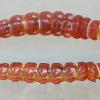35.065 Monochroa cytisella (Curtis, 1837)
Status and Distribution
Local, occasionally locally common, in southern and eastern England, the Midlands, Wales and the Channel Islands, becoming more localised in Ireland and northern England and very local in southern Scotland and Northern Ireland. There are some indications it may be expanding its range northwards with three new vice county records in central and western Scotland during 2014 and in 2020, however this could be down to increased recorder activity. The moth is apparently absent from many parts of the northern British Isles where bracken is abundant and it is suggested that it possibly prefers more sheltered sunny aspects (Sterling, Parsons and Lewington, Field Guide to the Micromoths of Great Britain and Ireland, 2012).

Provisional map
Finding the Moth
Larva: feeds within a slight swelling on the stem or within a side shoot during May and June, possibly earlier in some areas. Pupation occurs amongst detritus on the ground during June and sometimes into July.
Adult: occasionally disturbed amongst bracken during the day and comes readily to light.
Similar Species
This species is rather variable in colour from orange-brown to dark brown and there are a few similar-sized gelechiids with dark brown forewings and white streaks of varying kinds. The single, straight yellowish to whitish pencil-line from the leading edge of the wing at three quarters pointing towards the tornal area and reaching the middle of the forewing is distinctive. A fairly fresh specimen from Northern Ireland was found with the pale pencil-line almost obsolescent; all that remained was a very short line of pale scales on the costa.
Single brooded, from late June to mid-August.
Earliest: 16th June 1990 (VC113)
Latest: 2nd September 1962 (VC14) and 1989 (VC28)




















